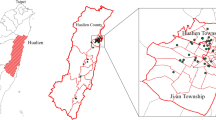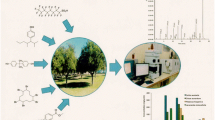Abstract
A method was developed for the analysis of paraquat residues in airborne particulate matter collected by filtration or impaction. The method is based on extraction of paraquat with 6N hydrochloric acid, transfer of residue to saturated ammonium bicarbonate solution, and reduction of the resulting residue with alkaline sodium borohydride to a mixture of two tertiary amines with subsequent determination by nitrogen-selective gas chromatography (GLC). Recoveries ranged from 74 to 96% for filters spiked at 0.05 microgram and above; the limit of detection is approximately 0.5 ng/m3 for high volume air samples. Paraquat concentrations measured in the air downwind from two commercial applications to cotton during spraying fell regularly from extrapolated interval-average values of 4.31 and 10.7μg/m3 at the 1 m downwind edge of the two fields to <50 ng/m3 at approximately 400 m downwind. Downwind samples taken 2 to 4 hr after spraying contained 1 to 10% as much paraquat as those during spraying, and by 5 to 7 hr no paraquat was detectable in the downwind air. Paraquat was also found in the airborne particulate matter during mechanical harvesting of one of the fields, the maximum interval-average values being 1,245 and 516 ng/m3 just outside and inside an open cab, respectively. The analytical findings for paraquat are compared with those forS,S,S-tributylphosphorotrithioate (DEF®), a component of the harvest aid mixture employed, and discussed in terms of occupational exposure, potential hazard, and recommended occupational practices.
Similar content being viewed by others
References
Akesson, N. B., W. E. Yates, and R. E. Cowden: Procedures for evaluating the potential losses during and following pesticide application. Paper No. 77-1504 presented at the 1977 Winter Meeting of the American Society of Agricultural Engineers, Chicago, IL (1977).
Anderson, P. S., and R. E. Lyle: The mechanism of the reduction of pyridinium ions by sodium borohydride, II. Tetra. Lett. 153 (1964).
Anonymous: Pesticide Use Report. California Department of Food and Agriculture, Sacramento, CA (1979).
Anonymous: TLV's threshold limit values for chemical substances in workroom air for 1973. J. Occup. Med.16, 39 (1974).
Byass, J. B., and J. R. Lake: Spray drift from a tractor-powered field sprayer. Pestic. Sci.8, 117 (1977).
Calderbank, A., and S. H. Yuen: An ion-exchange method for determining paraquat residues in food crops. Analyst90, 99 (1965).
Christensen, P., W. E. Yates, and N. B. Akesson: Meteorology and drift. Presented to the Fourth International Agricultural Aviation Congress (Symposium XV-Research Apparatus and Techniques-Chemicals and Distribution), Kingston, Ontario, Canada, August 25–29, 1969.
Fairshter, R. D.: Paraquat poisoning: An update. West. J. Med.128, 57 (1978).
Gage, J. C.: Toxicity of paraquat and diquat aerosols generated by a size-selective cyclone effect of particle size distribution. Br. J. Ind. Med.25, 304 (1968).
Hermann, B., and J. N. Seiber: Analysis of atmospheric residues from applications of DEF® and Folex® cotton defoliants. Paper No. 010 presented to the Division of Pesticide Chemistry, 178th National Meeting of the American Chemical Society, Washington, DC (1979).
Jellinek, S.: Advisory opinion concerning application of cotton defoliants in Arizona. Fed. Reg.44, 59956 (October 17, 1979).
Khan, S. U.: Determination of diquat and paraquat residues in soil by gas chromatography. J. Agric. Food Chem.22, 863 (1974).
King, R. R.: Gas Chromatographic determination of diquat residues in potato tubers. J. Agric. Food Chem.26, 1460 (1978).
Lawson, T. J., and S. Uk: The influence of wind turbulence, crop characteristics, and flying height on the dispersal of aerial sprays. Atmos. Environ.13, 711 (1979).
Lewis, R. G., and R. E. Lee, Jr.: Air pollution from pesticides: Sources, occurrence, and dispersion. In R. E. Lee, Jr. (ed.): Air Pollution from Pesticides and Agricultural Processes, Cleveland: CRC Press (1976).
Lyle, R. E., D. A. Nelson, and P. S. Anderson: The mechanism of the reduction of pyridinium ions with sodium borohydride. Tetra. Lett. 553 (1962).
Maddy, K. T.: Human health problems with the herbicide paraquat in California—1965 through 1974. Unpublished report to the California Department of Food and Agriculture, Sacramento, CA. April 2 (1975).
Needham, L., D. Paschal, Z. J. Rollen, J. Liddle, and D. Bayse: Determination of paraquat in marijuana by reversed-phase high performance liquid chromatography. J. Chromatogr. Sci.17, 87 (1979).
Pack, D. E.: Paraquat. In G. Zweig (ed.): Analytical Methods for Pesticides, Plant Growth Regulators, and Food Additives. New York: Academic Press (1967).
Popenoe, D.: Effects of paraquat aerosol on mouse lung. Arch. Pathol. Lab. Med.103, 331 (1979).
Pryde, A., and F. J. Darby: The analysis of paraquat in urine by high-speed liquid chromatography. J. Chromatogr.115, 107 (1975).
Seiber, J. N., G. A. Ferreira, B. Hermann, and J. E. Woodrow: Analysis of pesticidal residues in the air near agricultural treatment sites. In J. Harvey, Jr. (ed.): Recent Advances in Pesticide Analytical Methodology. ACS Symposium Series, Washington, DC. In press (1980).
Seiber, J. N., W. L. Winterlin, and M. M. McChesney: Residues of toxaphene, DEF, and paraquat in plant parts and gin waste from a treated cotton field. Arch. Environ. Contam. Toxicol.8, 125 (1979).
Smith, P. and D. Heath: Paraquat. CRC Crit. Revs. Toxicol.4, 411 (1976).
Soderquist, C. J., and D. G. Crosby: The gas Chromatographic determination of paraquat in water. Bull. Environ. Contam. Toxicol.8, 363 (1972).
Spector, W. S.: Handbook of Biological Data, Philadelphia: W. B. Saunders (1956).
Swan, A. A. B.: Ocular damage due to paraquat and diquat. Br. Med. J.2, 624 (1969).
Taylor, A. W.: Post-application volatilization of pesticides under field conditions. J. Air Pollut. Contr. Assoc.28, 922 (1978).
Ukai, S., K. Hirose, and S. Kawase: Forensic chemical studies on drugs. I. Determination of diquat and paraquat in aqueous herbicide preparations by gas chromatography. J. Hyg. Chem.19, 281 (1973).
Van Dijk, A., R. Ebberink, G. de Groot, R. A. A. Maes, J. M. C. Doze, and A. N. P. van Heyst: A rapid and sensitive assay for the determination of paraquat in plasma by gas-liquid chromatography. J. Analyt. Toxicol.1, 151 (1977).
Woodrow, J. E., and J. N. Seiber: Portable device with XAD-4 resin trap for sampling airborne residues of some organophosphorus pesticides. Anal. Chem.50, 1229 (1978).
Woodrow, J. E., J. N. Seiber, D. G. Crosby, K. W. Moilanen, C. J. Soderquist, and C. Mourer: Airborne and surface residues of parathion and its conversion products in a treated plum orchard environment. Arch. Environ. Contam. Toxicol.6, 175 (1977).
Zavala, D. C., and M. L. Rhodes: An effect of paraquat on the lungs of rabbits. Chest74, 418 (1978).
Author information
Authors and Affiliations
Rights and permissions
About this article
Cite this article
Seiber, J.N., Woodrow, J.E. Sampling and analysis of airborne residues of paraquat in treated cotton field environments. Arch. Environ. Contam. Toxicol. 10, 133–149 (1981). https://doi.org/10.1007/BF01055616
Received:
Accepted:
Issue Date:
DOI: https://doi.org/10.1007/BF01055616




